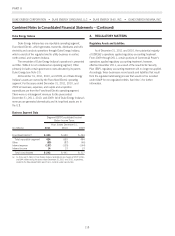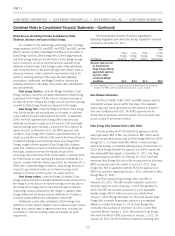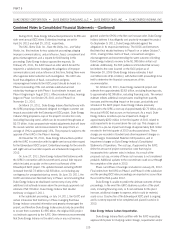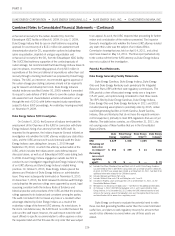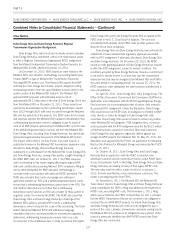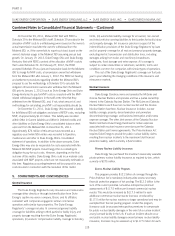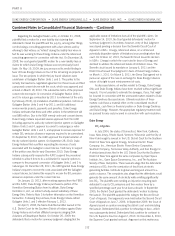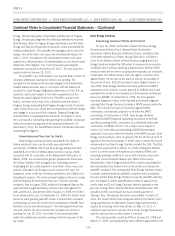Duke Energy 2011 Annual Report Download - page 146
Download and view the complete annual report
Please find page 146 of the 2011 Duke Energy annual report below. You can navigate through the pages in the report by either clicking on the pages listed below, or by using the keyword search tool below to find specific information within the annual report.
PART II
DUKE ENERGY CORPORATION •DUKE ENERGY CAROLINAS, LLC •DUKE ENERGY OHIO, INC. •DUKE ENERGY INDIANA, INC.
Combined Notes to Consolidated Financial Statements – (Continued)
enhanced oil recovery for the carbon dioxide (CO2)fromthe
Edwardsport IGCC facility on March 6, 2009. On July 7, 2009,
Duke Energy Indiana filed its case-in-chief testimony requesting
approval for cost recovery of a $121 million site assessment and
characterization plan for CO2sequestration options including deep
saline sequestration, depleted oil and gas sequestration and
enhanced oil recovery for the CO2from the Edwardsport IGCC facility.
The OUCC filed testimony supportive of the continuing study of
carbon storage, but recommended that Duke Energy Indiana break its
plan into phases, recommending approval of only $33 million in
expenditures at this time and deferral of expenditures rather than cost
recovery through a tracking mechanism as proposed by Duke Energy
Indiana. The CAC, an intervenor, recommended against approval of
the carbon storage plan stating customers should not be required to
pay for research and development costs. Duke Energy Indiana’s
rebuttal testimony was filed October 30, 2009, wherein it amended
its request to seek deferral of $42 million to cover the carbon storage
site assessment and characterization activities scheduled to occur
through the end of 2010, with further required study expenditures
subject to future IURC proceedings. An evidentiary hearing was held
on November 9, 2009.
Duke Energy Indiana IURC Investigation.
On October 5, 2010, the Governor of Indiana terminated the
employment of the Chairman of the IURC in connection with Duke
Energy Indiana’s hiring of an attorney from the IURC staff. As
requested by the governor, the Indiana Inspector General initiated an
investigation into whether the IURC attorney violated any state ethics
rules, and the IURC announced it would internally audit the Duke
Energy Indiana cases dating from January 1, 2010 through
September 30, 2010, on which this attorney worked while at the
IURC, which includes the Indiana storm costs deferral request
discussed above, as well as all Edwardsport IGCC cases dating back
to 2006. Duke Energy Indiana engaged an outside law firm to
conduct its own investigation regarding Duke Energy Indiana’s hiring
of an IURC attorney and Duke Energy Indiana’s related hiring
practices. On October 5, 2010, Duke Energy Indiana placed the
attorney and President of Duke Energy Indiana on administrative
leave. They were subsequently terminated on November 8, 2010.
On December 7, 2010, the IURC released its internal audit findings
concluding that the previous rulings were supported by sound, legal
reasoning consistent with the Indiana Rules of Evidence and
historical practice and procedures of the IURC and that the previous
rulings appeared to be balanced and consistent among the parties.
The audit concluded it did not reveal any bias or a resultant unfair
advantage obtained by Duke Energy Indiana as a result of the
evidentiary rulings of the former IURC attorney. As noted above, in
the storm cost deferral case, the IURC found no conflict between the
order and the staff report; however, the audit report noted the staff
report offered no specific recommendation to either approve or deny
the requested relief and that this was the only order that was subject
to an appeal. As such, the IURC reopened that proceeding for further
review and consideration of the evidence presented. The Inspector
General’s investigation into whether the former IURC attorney violated
any state ethics rules was the subject of an Indiana Ethics
Commission hearing that was held on April 14, 2011, and a final
report was issued on May 14, 2011. The final report pertained only
to the conduct of the former IURC attorney as Duke Energy Indiana
was not a subject of the investigation.
Potential Plant Retirements.
Duke Energy Generating Facility Retirements.
Duke Energy Carolinas, Duke Energy Indiana, Duke Energy
Ohio and Duke Energy Kentucky each periodically file Integrated
Resource Plans (IRP) with their state regulatory commissions. The
IRPs provide a view of forecasted energy needs over a long term
(15-20 years), and options being considered to meet those needs.
The IRP’s filed by Duke Energy Carolinas, Duke Energy Indiana,
Duke Energy Ohio and Duke Energy Kentucky in 2011 and 2010
included planning assumptions to potentially retire by 2015, certain
coal-fired generating facilities in North Carolina, South Carolina,
Indiana, Ohio and Kentucky that do not have the requisite emission
control equipment, primarily to meet EPA regulations that are not yet
effective. The table below contains, as of December 31, 2011, the
net carrying value of these facilities that are in the Consolidated
Balance Sheets.
Duke
Energy
Duke Energy
Carolinas(a)
Duke Energy
Ohio(b)(e)
Duke Energy
Indiana(c)
MW 3,329 1,356 1,025 948
Remaining net
book value
(in millions)(d) $ 353 $ 199 $ 14 $140
Remaining
non-current
regulatory
asset(f) $73 $— $— $73
(a) Includes Dan River, Riverbend, Lee and Buck units 5 and 6. Duke Energy Carolinas
has committed to retire 1,667 MW in conjunction with a Cliffside air permit settlement,
of which 311 MW have already been retired as of December 31, 2011. See Note 5 for
additional information related to the Cliffside air permit.
(b) Includes Beckjord and Miami Fort unit 6.
(c) Includes Wabash River units 2-6 and Gallagher units 1 and 3.
(d) Included in Property, plant and equipment, net as of December 31, 2011, on the
Consolidated Balance Sheets.
(e) Beckjord has no remaining net book value — See Note 12 for additional information.
(f) On February 1, 2012, 280 MW for Gallagher units 1 and 3 were retired by Duke
Energy Indiana. In its December 28, 2011 order, the IURC allowed recovery of and
return on the carrying value of the Gallagher units over the original life of these units
and classification of this amount as a regulatory asset.
Duke Energy continues to evaluate the potential need to retire
these coal-fired generating facilities earlier than the current estimated
useful lives, and plans to seek regulatory recovery for amounts that
would not be otherwise recovered when any of these assets are
retired.
126




